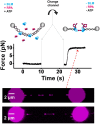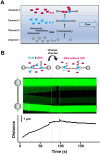Human RPA activates BLM's bidirectional DNA unwinding from a nick
- PMID: 32101168
- PMCID: PMC7065910
- DOI: 10.7554/eLife.54098
Human RPA activates BLM's bidirectional DNA unwinding from a nick
Abstract
BLM is a multifunctional helicase that plays critical roles in maintaining genome stability. It processes distinct DNA substrates, but not nicked DNA, during many steps in DNA replication and repair. However, how BLM prepares itself for diverse functions remains elusive. Here, using a combined single-molecule approach, we find that a high abundance of BLMs can indeed unidirectionally unwind dsDNA from a nick when an external destabilizing force is applied. Strikingly, human replication protein A (hRPA) not only ensures that limited quantities of BLMs processively unwind nicked dsDNA under a reduced force but also permits the translocation of BLMs on both intact and nicked ssDNAs, resulting in a bidirectional unwinding mode. This activation necessitates BLM targeting on the nick and the presence of free hRPAs in solution whereas direct interactions between them are dispensable. Our findings present novel DNA unwinding activities of BLM that potentially facilitate its function switching in DNA repair.
Keywords: BLM; DNA unwinding; RPA; chicken; helicase; molecular biophysics; optical tweezers; single molecule; structural biology.
© 2020, Qin et al.
Conflict of interest statement
ZQ, LB, XH, SZ, XZ, YL, ML, MM, XX, BS No competing interests declared
Figures


















Similar articles
-
The convergence of head-on DNA unwinding forks induces helicase oligomerization and activity transition.Proc Natl Acad Sci U S A. 2022 Jun 7;119(23):e2116462119. doi: 10.1073/pnas.2116462119. Epub 2022 Jun 3. Proc Natl Acad Sci U S A. 2022. PMID: 35658074 Free PMC article.
-
Does BLM helicase unwind nucleosomal DNA?Biochem Cell Biol. 2009 Dec;87(6):875-82. doi: 10.1139/o09-051. Biochem Cell Biol. 2009. PMID: 19935873 Free PMC article.
-
Single-molecule visualization of human BLM helicase as it acts upon double- and single-stranded DNA substrates.Nucleic Acids Res. 2019 Dec 2;47(21):11225-11237. doi: 10.1093/nar/gkz810. Nucleic Acids Res. 2019. PMID: 31544923 Free PMC article.
-
Physical and functional mapping of the replication protein a interaction domain of the werner and bloom syndrome helicases.J Biol Chem. 2005 Aug 19;280(33):29494-505. doi: 10.1074/jbc.M500653200. Epub 2005 Jun 17. J Biol Chem. 2005. PMID: 15965237
-
Unravelling the mechanisms of Type 1A topoisomerases using single-molecule approaches.Nucleic Acids Res. 2021 Jun 4;49(10):5470-5492. doi: 10.1093/nar/gkab239. Nucleic Acids Res. 2021. PMID: 33963870 Free PMC article. Review.
Cited by
-
Looking at Biomolecular Interactions through the Lens of Correlated Fluorescence Microscopy and Optical Tweezers.Int J Mol Sci. 2023 Jan 31;24(3):2668. doi: 10.3390/ijms24032668. Int J Mol Sci. 2023. PMID: 36768987 Free PMC article. Review.
-
Replication protein A plays multifaceted roles complementary to specialized helicases in processing G-quadruplex DNA.iScience. 2021 May 1;24(5):102493. doi: 10.1016/j.isci.2021.102493. eCollection 2021 May 21. iScience. 2021. PMID: 34113828 Free PMC article.
-
Targeting of RecQ Helicases as a Novel Therapeutic Strategy for Ovarian Cancer.Cancers (Basel). 2022 Feb 26;14(5):1219. doi: 10.3390/cancers14051219. Cancers (Basel). 2022. PMID: 35267530 Free PMC article. Review.
-
Observing Protein One-Dimensional Sliding: Methodology and Biological Significance.Biomolecules. 2021 Nov 2;11(11):1618. doi: 10.3390/biom11111618. Biomolecules. 2021. PMID: 34827616 Free PMC article. Review.
-
Telomeres and Cancer.Life (Basel). 2021 Dec 16;11(12):1405. doi: 10.3390/life11121405. Life (Basel). 2021. PMID: 34947936 Free PMC article. Review.
References
Publication types
MeSH terms
Substances
Grants and funding
- 2016YFA0500902/Ministry of Science and Technology of the People's Republic of China
- 2017YFA0106700/Ministry of Science and Technology of the People's Republic of China
- 19ZR1434100/Shanghai Natural Science Foundation
- PLBIO2017-167/Institut National Du Cancer
- EL2028.LNCC/MaM/The French National League Against Cancer
LinkOut - more resources
Full Text Sources

